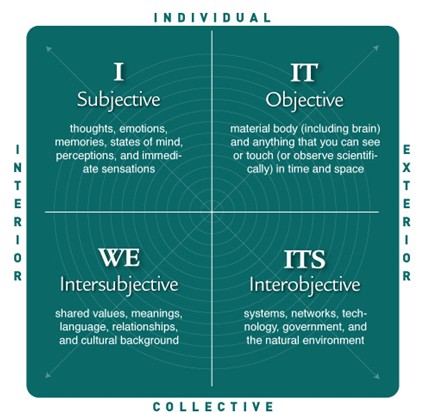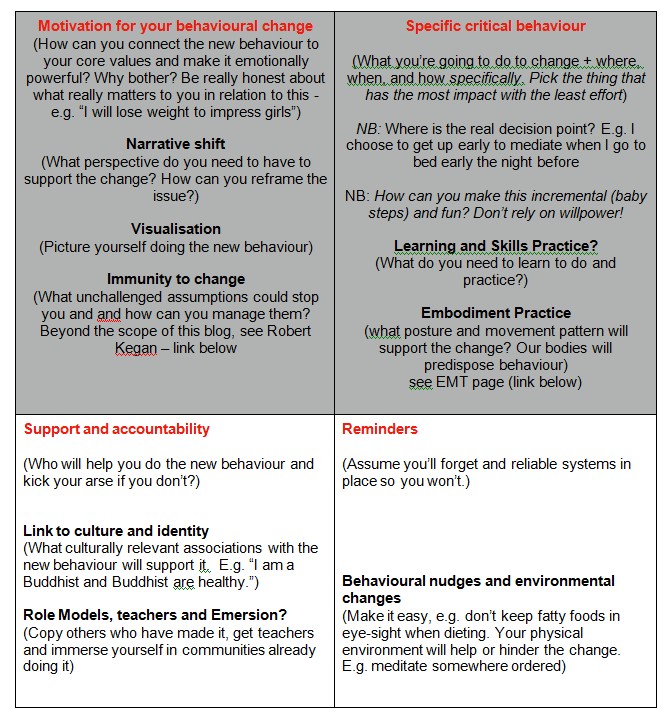Establishing long-term behavioural change is the holy-grail of training. Put bluntly, without helping people do stuff differently training is a waste of time and clients might as well save some money and use Wikipedia instead. Beyond the training and coaching world I work in, everyone has an interest in changing some aspect of their lives, whether that be weight loss or exercise, relationship patterns or work behaviours, yet as failed New Year’s resolutions show, this can be quite tricky. There are many models of behavioural change but most are partial and therefore partially effective. I have gathered many of these together and use a combination of what I have found worked best with various clients. I make sense of them using Ken Wilber’s “quadrants” (see below) which are one way of dividing reality into it’s most fundamentals aspects of interior and exterior, singular and plural.
as well save some money and use Wikipedia instead. Beyond the training and coaching world I work in, everyone has an interest in changing some aspect of their lives, whether that be weight loss or exercise, relationship patterns or work behaviours, yet as failed New Year’s resolutions show, this can be quite tricky. There are many models of behavioural change but most are partial and therefore partially effective. I have gathered many of these together and use a combination of what I have found worked best with various clients. I make sense of them using Ken Wilber’s “quadrants” (see below) which are one way of dividing reality into it’s most fundamentals aspects of interior and exterior, singular and plural.
These are all the angles that need to be covered to get your own or another’s behaviour to change reliably. One of two of them probably wont do it. This video shows a similar system which has been independently produced and while lacking some of the more sophisticated psychological ones or a sense of embodiment, still covers most of the main bases and has a good research base. It’s also cute: Hand-washing video
Translated into behavioural change strategies the quadrant model below is produced. Any one of these elements could be the subject of a whole blog article but here they are in brief as questions. When pushed for time I ask people to use the four at the top of each box in red, although others such as narrative and embodiment are also really crucial and if these concepts are understood should also be included. What is important in the whole effort is producing ease, by both increasing force (e.g. connecting to values and support) and decreasing resistance (e.g. by making fun).
An Example – Sarah’s DeStress Plan
(based on a real example)
On a day-long stress training at work Sarah experiences making gratitude lists and doing sitting meditation as having a profound impact on her stress levels. Now she could have had a nice time, got some good intentions to practice and then left the training to do what she’d always done. In my experience actually, this is nearly always what happens unless at least some of the following process is done.
Luckily in this case she spent the last twenty minutes of the workshop being coached through this plan. She decide to meditate for ten minutes each morning (realistic) and make a gratitude list each night before bed. She actually suggest doing a whole bunch of other stuff but I limited her to two things that have seemed to be particularly powerful – one or two things that stick is better than ten that don’t. Her motivation for doing this is that her mother died of a heart attack about the same age and she wants to see her grandchild grow up. She spends some time connecting to this emotionally and imaging both possibilities. She also realises she has to shift her story from “meditation is for hippies” to “meditation and gratitude have been proven to reduce stress and are a part of my Christian heritage (culture|)”. She has some roles models for gratitude and meditative calmness at her church that she respects. Sarah sets a reminder on her phone to go to bed ten minutes earlier to go off in the early evening (the critical decision point). Having done some embodied work with me she also knows there is a “a body” of slowing down to mediate (more back) and a body of resentment (tight , less open) which she will also practice. She decides to make a small corner of her living room ordered and beautiful to meditate in and decides to go to a group once a week to encourage her daily self-practice. I get her to look up groups on the net there and then. She commits to her colleague, Sandra, who is also taking up meditation and they put up a chart by their desks to make it a game and keep accountability and I agree to mail them in intervals for the next 90 days.
This process worked for Sarah (name changed) a busy business-woman and many others I have worked with. It can seem like a lot at first but can be done in 15-20 minutes thoroughly and this is what it takes to reliably establish behavioural change. Give it a try!
Links:
You may also like to look at the following articles:
If your organisation is looking at management training in the workplace then call us on 01273 906828 .
To receive the Integration Training newsletter with free tips and news of events please click on the link below


Katherine
Mark, I picked this up from your Twitter feed and have been back to it several times. Love the video. I’ve found the concepts presented here very insightful and useful.
warkmalsh
thanks Katherine 🙂